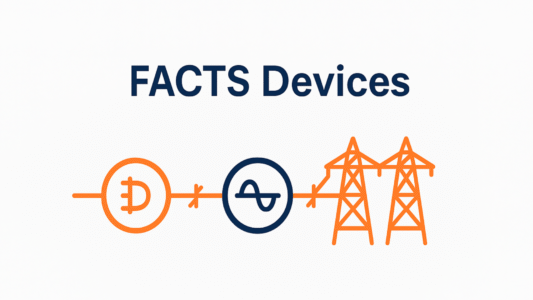FACTS devices in modern power systems
Author: PPD Team Date: 09/06/2025

Flexible AC transmission system (FACTS) devices use power electronics to dynamically control voltage, impedance and phase angle in AC networks. They improve stability, boost transfer capacity, and enhance power quality in heavily loaded grids and those with high renewable penetration.
Traditional transmission systems are rigid and slow to respond. FACTS devices solve this by adding voltage or current in a controlled way, either in series or parallel with the line. This real-time control helps reduce losses, prevent voltage problems, and control power swings. As a result, the grid can run closer to its limits without failing.
Series controllers are connected in line with transmission paths. Devices like Thyristor-Controlled Series Capacitors (TCSC) adjust the line’s reactance to improve power transfer and control subsynchronous resonance. Static Synchronous Series Compensators (SSSC) use voltage-source converters to inject a variable voltage, allowing both capacitive and inductive support. These series devices can increase a line’s power transfer capacity by up to 50 per cent during changing grid conditions.
Shunt controllers connect at specific points in the network to manage voltage. Static Var Compensators (SVC) and Static Synchronous Compensators (STATCOM) do this by injecting or absorbing reactive current. STATCOMs respond faster and produce fewer harmonics than SVCs, making them more suitable for handling quick changes from solar and wind power. Both devices help maintain voltage levels and improve power factor, which supports stable power for sensitive users.
Combined series–shunt devices integrate both functions in a single unit. The unified power flow controller (UPFC) comprises two voltage‐source converters sharing a DC link. One converter connects in shunt to support DC‐link voltage, while the other connects in series to control the line voltage magnitude and phase angle. UPFCs uniquely enable independent control of active and reactive power flow, offering unparalleled grid flexibility.
Distributed FACTS (D-FACTS) devices take a modular approach. Small‐rated converters placed at multiple line segments provide finer control and redundancy. Their distributed nature limits the impact of a single module failure and simplifies maintenance, while coordinated control through wide‐area measurements enhances overall resilience.
FACTS devices address key power quality challenges. They rapidly compensate voltage sags and swells, suppress harmonics via active filtering techniques, and balance unbalanced loads. Selective harmonic elimination and active power filtering within FACTS inverters maintain total harmonic distortion below acceptable thresholds, protecting industrial and data center operations from equipment damage.
Optimal placement and sizing of FACTS devices are critical given their high costs. Early methods used sensitivity factors and power flow indices to identify candidate buses. Recent approaches employ metaheuristic algorithms—genetic algorithms, particle swarm optimization, differential evolution—and hybrid techniques combining analytical sensitivity and metaheuristics. These solve multi‐objective problems, minimizing losses, improving voltage profiles, and reducing generation costs while respecting system constraints.
Genetic algorithms mimic natural selection to explore large solution spaces. They handle multi‐objective functions and noisy, nonconvex regions effectively. Particle swarm optimization leverages social behavior models to converge rapidly on optimal FACTS locations, often outperforming evolutionary programming in loading factor improvements. Simulated annealing and tabu search add robustness against local optima, ensuring global solution quality.
Increasing renewable integration adds variability and uncertainty. Stochastic optimization and scenario‐based planning incorporate wind and solar generation profiles when allocating FACTS. This ensures robust performance under fluctuating conditions, maintaining voltage stability and damping oscillations caused by intermittent resources.
Smart grid initiatives integrate FACTS with advanced monitoring. Wide‐area measurement systems and phasor data enable coordinated FACTS control across regions. This synchronized operation enhances transient stability and allows corrective action during contingencies, improving security margins and preventing cascading failures.
Emerging control strategies incorporate machine learning and artificial intelligence. Adaptive algorithms tune FACTS controllers in real time, optimizing response to network changes and reducing reliance on manual set‐point adjustments. Such AI‐driven controls promise faster convergence and improved damping under highly nonlinear conditions.
Cost remains a barrier. Research into new semiconductor materials—silicon carbide and gallium nitride—aims to reduce losses and thermal management requirements, lowering device footprint and installation expense. Combining FACTS with energy storage, superconductor current limiters or superconducting magnetic energy storage (SMES) may further enhance capability while reducing lifecycle costs.
Looking forward, more general FACTS configurations are anticipated. Hybrid devices merging STATCOM with thyristor‐switched capacitors will extend operational range. Explosion‐proof FACTS for mining and other harsh environments are under development. D-FACTS proliferation, multi‐objective metaheuristic optimization, and AI integration will drive next‐generation FACTS deployment, supporting zero‐carbon, resilient power systems worldwide.
References
Muddu Chethan and Ravi Kuppan. A review of FACTS device implementation in power systems using optimization techniques. Journal of Engineering and Applied Science, 71:18, 2024.
Ban H. Alajrash et al. A comprehensive review of FACTS devices in modern power systems: Addressing power quality, optimal placement, and stability with renewable energy penetration. Energy Reports, 11:5350–5371, 2024.
